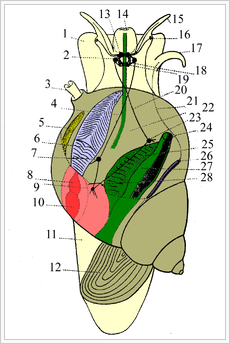Adaptation
Adaptation is closely related to evolutionary
biology because adaptation refers to the traits that are acquired,
altered, or lost to increase the fitness of the organism and help
the organism better adjust to its environment (The
Free Dictionary 2012).
There has been a large amount of adaptations that have led to what
the species Patera pennsylvanica are today, some of which are
covered in this section. Due to the lack of specific information
about the species Patera pennsylvanica adaptations from other
taxonomic levels of Patera pennsylvanica will be analyzed.
Alex Tompa
looked at how common
calcified eggs are within the order Stylommatophora, the taxonomic
order for Patera pennsylvanica (Tompa 2005). It was found that 36 of the
65 families of the order Stylommatophora are either partially
calcified or heavily calcified, an advantageous characteristic (Tompa
2005). The benefits of calcified eggs include calcium’s role in
mechanical support of the shell and its contents (Tompa 2005). Furthermore
calcified eggs enable the embryonic shell to be ready for hatching
by providing the embryo with calcium (Tompa 2005). These functions make calcified
eggs a terrestrial adaption to many families within the order Stylommatophora
(Tompa 2005).
Torsion is a gastropod synapomorphy (ZipcodeZoo
2012). According to Ghiselin, theories by Lang and Naef accurately describe the adaptive
importance of torsion by taking into account limpets, the ancestor
of gastropods (Ghiselin 1966). Limpets were evolving shells of
increased height to the point of instability and a lack of balance,
negatively affecting locomotion and respiration which ultimately
threatened survival (Ghiselin 1966). Torsion shifts the center of
gravity back to a stable point by placing the mantle cavity and the
shell on alternate sides, returning balance and stability
effectively for organisms to maintain upright and move efficiently (Ghiselin
1966).
The species Patera pennsylvanica is
within the informal order Pulmonata (ZipcodeZoo
2012). Barnhart found that
Pulmonates have the capability of
undergoing periods of dormancy that are capable
of withstanding lengthened periods of little food and water
(Barnhart 1986). Morphologically, the shells and mantle collar create
a waterproof seal, limiting water loss (Barnhart
1986). However the
opening to the respiratory system in gastropods known as the pneumostome essentially breaks this seal (Wikipedia
2012),
with the amount of time the pneumostome is opened having a directly
proportional relationship with water loss (Barnhart
1986). The amount
of time the pneumostome is open can be regulated and ultimately
reduced by establishing partial pressure differences between the air
and lung with oxygen and carbon dioxide and by decreasing metabolic
rate (Barnhart 1986).
It is beneficial for ATP
production to have the ability to transport oxygen through the
circulatory system (van Holde
et al. 2001).
In the class Gastropoda, hemocyanin is the oxygen carrying molecule
(ZipcodeZoo 2012).
Before hemocyanin was evolved, photosynthetic production of oxygen
placed selective pressure on other organisms to neutralize and even
benefit from oxygen (van Holde et al. 2001).
Enzymes made up of copper and iron functioned in doing this but as
time went on diffusion limited oxygen supply, hindering ATP
production (van Holde et al. 2001).
The rise of hemocyanin was the evolutionary solution to this problem
for gastropods (van Holde et al. 2001).
The structure of hemocyanin contributes to its function due to its
size and its multiple binding sites (van Holde et
al. 2001).
The large size of hemocyanin ensures osmotic pressure does not
become too high while hemocyanin’s multiple binding sites makes the
molecule cooperative, meaning oxygen binds to hemocyanin when needed
and oxygen is released from hemocyanin when needed (van Holde
et al. 2001).
To summarize, hemocyanin is an adaptation that helped gastropods,
including Patera pennsylvanica, meet metabolic
requirements (van Holde et al. 2001).
Fi
